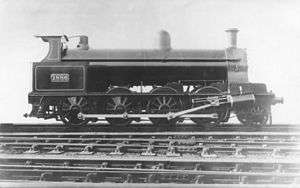LNWR Class E
| LNWR Class E | |||||||||||||||||||||||||||||
|---|---|---|---|---|---|---|---|---|---|---|---|---|---|---|---|---|---|---|---|---|---|---|---|---|---|---|---|---|---|
 No. 1886 without tender | |||||||||||||||||||||||||||||
| |||||||||||||||||||||||||||||
| |||||||||||||||||||||||||||||
| |||||||||||||||||||||||||||||
The London and North Western Railway (LNWR) Class E was a class of 2-8-0 steam locomotives in service between 1904 and 1928.
History

26 were rebuilt by George Whale from Class B 4-cylinder compounds with the simple addition of a leading pony truck to reduce excessive front overhang between 1904-1908. The only alteration was to wheelbase and weight, but when the letter classification system was introduced in 1911, this took them into a different class.
Two of Class Es were further rebuilt to Class Fs by the replacement of the 4'3" diameter boiler with a larger 5'2" diameter boiler; these being 1038 in 1907 and 647 in 1908.
From 1917, Charles Bowen Cooke started to rebuild the remaining 24 Class Es into LNWR Class G1 0-8-0s with simple expansion engines. 12 had been so treated by the grouping of 1923, and a further pair were treated in January and February of that year. Of the remaining ten Class Es, the LMS allocated them the numbers 9600-9. A further four were rebuilt to Class G1 in 1923-4, while the remaining six engines were withdrawn still as Class Es in 1927/8, two of them never receiving their allocated LMS No. None was preserved.
List of locomotives
| LNWR no. | Rebuilt from B | LMS no. | Fate | Notes |
|---|---|---|---|---|
| 1883 | 1904 | Rebuilt to G1 1918 | [1] | |
| 1884 | 1904 | Rebuilt to G1 1917 | [1] | |
| 1885 | 1905 | Rebuilt to G1 1917 | [1] | |
| 1886 | 1904 | Rebuilt to G1 1923 | [1] | |
| 1888 | 1904 | (9600) | Rebuilt to G1 1924 | [1] |
| 1889 | 1906 | Rebuilt to G1 1920 | [2] | |
| 905 | 1905 | 9601 | Withdrawn 1928 | [2] |
| 18 | 1905 | (9602) | Withdrawn 1928 | [2] |
| 2558 | 1906 | 9603 | Withdrawn 1928 | [3] |
| 2563 | 1908 | (9604) | Rebuilt to G1 1924 | [3] |
| 1017 | 1906 | (9605) | Withdrawn 1927 | [3] |
| 1038 | 1905 | Rebuilt to F 1907 | [3] | |
| 1042 | 1906 | 9606 | Withdrawn 1928 | [3] |
| 1064 | 1906 | (9607) | Rebuilt to G1 1923 | [4] |
| 1065 | 1906 | Rebuilt to G1 1919 | [4] | |
| 1222 | 1906 | 9608 | Withdrawn 1928 | [4] |
| 1223 | 1906 | Rebuilt to G1 1921 | [4] | |
| 1227 | 1908 | Rebuilt to G1 1921 | [4] | |
| 1236 | 1906 | Rebuilt to G1 1921 | [4] | |
| 2574 | 1906 | Rebuilt to G1 1920 | [5] | |
| 1586 | 1906 | Rebuilt to G1 1921 | [6] | |
| 647 | 1907 | Rebuilt to F 1908 | [6] | |
| 1585 | 1906 | (9609) | Rebuilt to G1 1923 | [7] |
| 2056 | 1907 | Rebuilt to G1 1921 | [7] | |
| 437 | 1906 | Rebuilt to G1 1922 | [7] | |
| 2169 | 1906 | Rebuilt to G1 1923 | [7] |
LMS numbers in parentheses were not carried prior to rebuilding as G1 or withdrawal.
Notes
- 1 2 3 4 5 Baxter 1979, p. 254.
- 1 2 3 Baxter 1979, p. 255.
- 1 2 3 4 5 Baxter 1979, p. 256.
- 1 2 3 4 5 6 Baxter 1979, p. 257.
- ↑ Baxter 1979, p. 258.
- 1 2 Baxter 1979, p. 259.
- 1 2 3 4 Baxter 1979, p. 260.
References
- Baxter, Bertram (1979). Baxter, David, ed. British Locomotive Catalogue 1825-1923, volume 2B: London and North Western Railway and its constituent companies. Ashbourne: Moorland Publishing. ISBN 0-903485-84-2.
Further reading
- Essery, Bob; Jenkinson, David. An Illustrated Review of LMS Locomotives Vol. 2 Absorbed Pre-Group Classes Western and Central Divisions.
- Talbot, Edward. The London & North Western Railway Eight-Coupled Goods Engines.
- Yeadon, Willie. Yeadon's Compendium of LNWR Locomotives Vol 2 Goods Tender Engines.
External links
- LNWRS Webb page on the Class E (NB lifetime is incorrect as it includes G1 rebuilds)